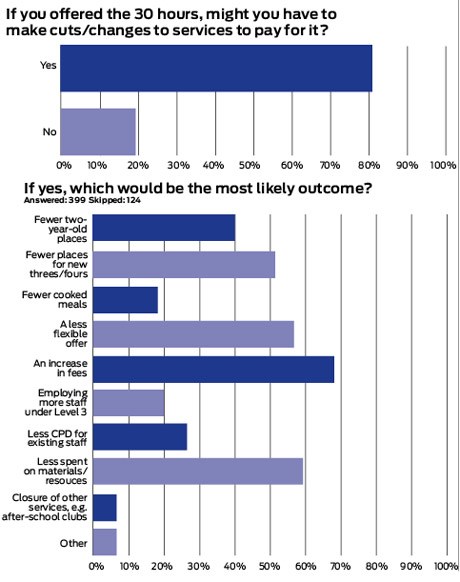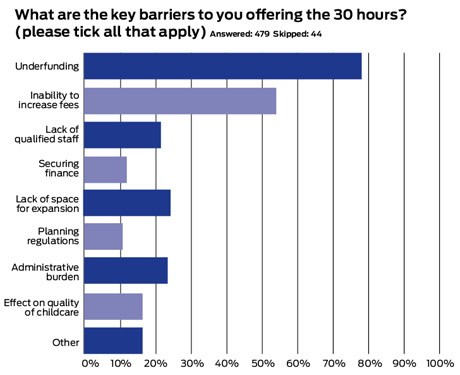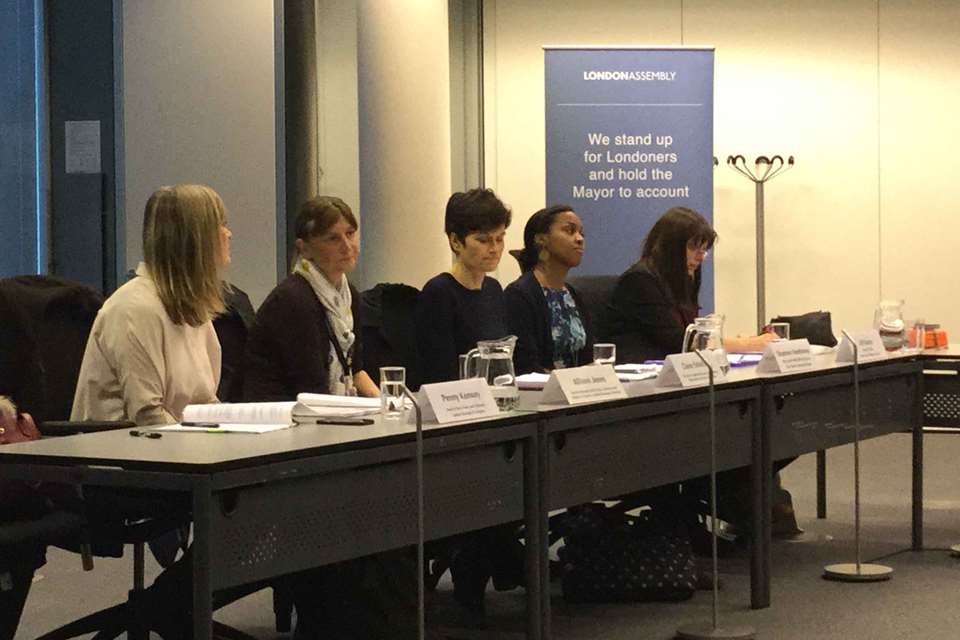Nursery Management: Business - Costs cocktail
Hannah Crown
Monday, March 21, 2016
How is the impact of the 30 hours, National Living Wage and other increased business costs going to be felt across the sector? Hannah Crown reports

Childcare will become more expensive, less flexible and less accessible as a direct impact of the 30 hours, our exclusive survey shows.
Four in five of 523 respondents say the Government’s plan to extend the 15 funded hours, which comes alongside unprecedented increases in staffing bills, is likely to mean sacrifices to services elsewhere – or hikes in fees.
Of the 81 per cent who said they would be forced to cut or change services, fee increases were the most likely outcome (67 per cent of settings), while 56 per cent said their offer would be less flexible.
The Government’s flagship policy, to double the existing 15 hours of childcare offered to parents of three- and four-year-olds for 38 weeks of the year, is to come in in 2017. But the 30 hours scheme has been dogged by claims of underfunding, backed by reports from the Institute for Public Policy Research and the Pre-school Learning Alliance, and lack of certainty about what it is trying to achieve, supported by reports from the Institute of Fiscal Studies and National Audit Office (NAO).
In response, the Government launched a funding review that recommended an hourly rate of £4.88 including the Early Years Pupil Premium. But settings claim the new rate, which is estimated to be around £4.39 for threes and fours after local authority topslicing, is likely to leave them with a deficit.
Marg Randles, co-founder and managing director of Busy Bees, the UK’s largest nursery chain, says that under the current system, ‘a nursery can easily lose half of its daily fee income if it delivers funded places’.
She says, ‘Without the detail on the implementation it is difficult to give a final assessment on how the 30 hours will really impact… [But] the impact of the National Living Wage and the introduction of 30 hours will be challenging and will require an imaginative strategy, but we will look to keep any fee rises to a minimum. We are undoubtedly apprehensive because we want to support the 30 hours, but the agreed hourly rate does not always cover the standard daily rate.’
One impact of the policy will actually be to reduce the number of three- and four-year-old places available, said 51 per cent of respondents. One said ‘We are currently full so couldn’t offer 30 hours. Is it better to offer 15 hours to more children or 30 hours to fewer? Where would the others go?’
Beth Thomas, childcare practitioner at St Matthew’s Pre-School, which serves a disadvantaged area in Worthing, says the setting turned down the chance to be part of the 30 hours pilot because the most disadvantaged parents don’t qualify. ‘We offer places to around 60 children on a part-time basis as most of them do their funded 15 hours. If we increase funded hours to 30, we reduce the number of children we can serve.
‘As three-quarters of our parents don’t qualify, it means better-off parents will take places away from parents who are worse off. Our setting would be taken up with children who need it less.’ Eligibility criteria are: both parents working, or a sole parent working; and each parent earning an average weekly equivalent to 16 hours at the National Minimum Wage, capped at £100,000 per year.
‘In terms of closing the gap between the most disadvantaged and the rest, this will potentially undo the work of the two-year-old places by the time the children start school,’ Steve Scott of Happy Kids Childcare says of the eligibility criteria. He is considering limiting the number of 30 hours places offered by his group, which has three-quarters of its children on the current free entitlement, and he says, ‘We will prioritise two-year-old funded places as our company was created to support disadvantaged families first. We would ensure all [parents of the three- and four-year-olds] could access the 15 hours and then restrict the 30 hours if needed.
‘As well as full and half days, we would potentially only offer five-hour sessions instead of the three-, six- and eight-hour sessions currently available, and on specific days, which goes against the idea of a flexible offering.’
Ms Randles says, ‘As the 30-hour entitlement will only be available to children of working parents, priority will be given to children already attending a setting. If providers are left to deliver it with flexibility, and can accommodate the free entitlement on days when they have less children, this will maximise the number of places available.’ She adds that where councils dictate ‘maximum flexibility for parents’, providers may find it challenging to generate sufficient income.
Parents are already facing a shortage of places under the current system, however. A report in February by the Family and Childcare Trust found that only 45 per cent of local councils in England said they had enough childcare for parents who work full-time under the existing 15 hours scheme.
Fees and other costs
‘We will have a great deal of difficulty offering the 30 hours as it stands,’ says London Early Years Foundation director of finance Neil Fenton. The company operates in disadvantaged areas around greater London, with 48 per cent of its parents not paying any fees, and has offered to take part in the 30 hours pilot on a setting-by-setting basis.
‘We can’t hope to do something which is ultimately going to drive us out of business and make life worse for the already disadvantaged children of London. We already have an awful lot of parents who are struggling to pay fees,’ Mr Fenton says.
He points out that the 30 hours system means providers are ‘losing twice. Not only are we providing childcare at less than cost, but we are also losing the ability to recover profits through additional hours.’
The majority of our respondents agreed, with 76 per cent saying the biggest barrier to offering the 30 hours was the ‘underfunded rate combined with a reduced ability to charge for surplus hours’.
When asked if they had or would put up fees this year, nearly three-quarters (72 per cent) said yes. The average increase is 4.6 per cent, close to that shown in the NDNA annual nursery survey (4 per cent).
But this would not be enough to recoup lost income, said 53 per cent.
There is a myriad of other financial pressures, including frozen local authority funding rates. Respondents have had a paltry average 3p rise on their hourly rates between 2015-16 and 2016-17. A report from the NAO this month backed this, saying funding for free childcare has stayed the same since 2013-14, so providers have faced real-term cuts.
The report also said new average funding rates were at levels ‘designed to encourage efficiency’.
Our survey found efficiencies included spending less on resources (59 per cent), less CPD (26 per cent) and more sub Level 3 staff (a fifth).While meals were a protected area for many, 19 per cent of settings still said they would be likely to offer less cooked food as a result of the 30 hours. This follows recent warnings that packed lunches for children are ‘typically less varied and nutritious than a hot meal’, according to the Children’s Food Trust’s Patricia Mucavele.
Another impact could be meal charges going up. Nichola Bamber, owner of Footprints Child Care in Preston, says, ‘We can’t stop doing hot meals, because some children need them.’ But she adds that, under the 30 hours, it may raise the price from around £6 per three-day week to £10 per week, for breakfast, cooked lunch and a snack – and is in the process of surveying parents on the matter.
Purnima Tanuku, chief executive of NDNA, says, ‘With years of underfunding, any further cuts or efficiencies will have a detrimental effect on the children settings are caring for. Being pushed to take measures such as cutting hot meals would be unpopular with parents and unfair for the children.’
We also found that the average impact of pension auto-enrolment was a 2 per cent increase to the wage bill. Meanwhile, business rates rose 5 per cent on average last year, with the majority of respondents expecting another increase this year.

Ratios and ‘flexible’ contracts
In its review of childcare costs, the Department for Education said that savings of up to 15 per cent could be made by ensuring closer adherence to legal ratios: ‘Where providers are operating with slack in the system, they incur higher costs… there is evidence that higher quality can be achieved by providers operating close to or at statutory ratio.’ However, according to our survey, 69 per cent of employers would not consider this possibility, with the majority of these (66 per cent) saying doing so would be ‘bad for quality of practice’.
Of the 31 per cent who said they would, just 17 per cent agreed with the characterisation of spare ‘slack’ in the system, while the 58 per cent characterised it as being financially driven, with respondents saying, ‘I only do this as a last resort as I feel quality and safety will suffer’ and, ‘I have a small amount of slack in the system which I’m taking out. This means more risk of being understaffed though due to sickness. I have put my fees up by 7 per cent this year and will continue to pass on my costs to my customers. Other local nurseries have increased at a higher rate than us so, ultimately, I doubt if parents are actually going to gain anything. Because of the Level 3 shortage, we are proportionally hiring more unqualified and younger staff.’ Interestingly, a quarter of these respondents agreed with the statement that ‘fewer permanent staff and more flexible contracts is going to be the way forward.’
Flexible staffing models was another DfE suggestion, with ‘potentially big savings… available using more variable staffing models to recognise peaks and troughs in occupancy’. Again, the majority – 60 per cent – said they would not consider any flexible contracts. Of those that would, bank and part-time staff were popular choices, and variable contracts, which include zero hours, were opted for by 52 per cent of respondents.
Lynda Symons, owner of Kidz Kabin in Muswell Hill, London, says, ‘The idea of zero-hours contracts is likely to compromise continuity of care. Children need key workers who they can bond with.
‘Many private settings work on a ratio of 1:6 rather than 1:8, as expecting three staff to manage 24 three- and four-year-olds is not just challenging, it would compromise quality. Staff need breaks, time out for planning.’
She has started a petition asking for the second batch of 15 hours to be means-tested. ‘Sam Gyimah says nurseries are holding the Government to ransom – it is the other way around. They talk about getting families into work and making childcare affordable, but are penalising the very industry that can facilitate this.’
Neil Leitch, chief executive of the Pre-school Learning Alliance, says, ‘Despite the Government’s insistence that the sector should make “efficiencies” by relying on temporary staff and working to ratio limits, the majority of the providers continue to (rightly) reject these suggestions due to serious concerns over the impact on quality. As a result, the introduction of the 30-hour offer is likely to lead to a reduction in funded places and an increase in parental fees.
‘Given that free entitlement take-up is already low in areas of deprivation, any further reduction of places is likely to have a particularly detrimental impact on those families most in need.’
LEYF’s Mr Fenton adds, ‘What is missing from the debate is that somebody has to pay. What the Government is proposing doesn’t cover the costs of childcare, so if we were to deliver this, fee increases are inevitable. We don’t have the level of profit that allows us to subsidise a further 15 hours. Underpayment of the 30 hours is unsustainable.’
Catherine West, Labour MP for Hornsey and Wood Green, says the Tory pledge for 30 hours was simply ‘war games’ to trump Labour’s pre-election pledge of 25. ‘The Government is committed to an anti-austerity project and it doesn’t believe in investing. At the moment I don’t think it has the chance of meeting that pledge.’
A spokesman for the DfE says, ‘Spend on childcare will increase from £5bn in 2015-16 to over £6bn by 2019-20, while [the Government] has committed to introducing an early years national funding formula to ensure that our record investment is distributed fairly.
‘These findings don’t match what we’re seeing on the ground. More parents than ever are accessing high-quality free childcare and, thanks to our plan to double the offer for working parents, we expect that trend to continue. We are backing hardworking families and funding the sector with £1bn extra funding every year by 2020, including £300m annually to increase the national average funding rate, to incentivise and attract providers to deliver the full 30-hour free offer. This extra funding was based on our review into the cost of delivering childcare, the most comprehensive analysis of this market ever, which involved extensive consultation with the sector.
‘A recent NDNA survey found nearly all nurseries (97 per cent) are delivering funded places for three- and four-year-olds. Our ambition is supported by the huge levels of interest in our early implementers scheme, which will trial the 30-hour offer a year ahead of schedule with nearly 100 local authorities and 1,700 providers asking to take part.’
HOW SETTINGS ARE APPROACHING THE NATIONAL LIVING WAGE (NLW)
Our survey shows that close to a fifth (19 per cent) of settings already pay 91-100 per cent of their eligible staff the NLW (£7.20 an hour for all workers aged 25 and older – mandatory from April 2016). For those that don’t, how will they go about it?
A KPMG report last year on the impact of introducing the living wage in Birmingham found that giving wage increases to just those staff who are below the minimum wage was ‘not a likely outcome’ as ‘employers wish to maintain pay differentials’. But we found that settings are most likely to increase salaries of just those staff who receive below the NLW (20 per cent of respondents), while 17 per cent would increase pay by the same percentage for all staff.
For some settings, a pro-rata increase would mean a prohibitive wage bill. One employer, one of 10 per cent who would increase some staff wages in addition to those impacted by NLW, said around 10 per cent of his staff were not on the NLW. ‘Some of our staff are having 11 per cent (or more) salary rises as a result of the NLW. The majority of staff it is going to affect are not child-facing – they are the housekeepers, cleaners, lunchtime assistants. One employee’s salary will rise by £2,000.
‘We are doing the increase selectively. If we did the 11 per cent increase for everybody it would be an enormous cost and we couldn’t afford it. It has forced our hand in giving greater pay rises to people we wouldn’t necessarily have given them to.’
Another said, ‘If there were equal increases across the board for all staff, the top end tends to be less well off from salary inflation, so you get senior staff leaving. We don’t know yet how we are going to do it.’
For childminders, who tend to receive lower rates, the picture is especially grim. A childminder responding to our survey said, ‘I only get paid £3.48 an hour per child and have to pay my assistant £7.20 for the National Living Wage. Then on top of this there is the cost of setting up a pension scheme and paying in 1 per cent of wages, going up to 3 per cent over the next three years. We cannot increase our ratios and are allowed three children each. So the maths is £3.48 × 3 = £10.44. That leaves £3 per hour to pay for all overheads, and now on top of this to pay for training. Some days we are not full and only have four or five children in – not a full allowance of six.’
Busy Bees’ Ms Randles adds that its ‘fee rate will be in line with previous years. We have made the decision that the income generated will be spent on the NLW.’
CASE STUDY: FENNIES DAY NURSERIES
 With eight settings in and around south London, and expansion plans, Fennies aims for competitive pricing against the big chains. It has 250 staff and qualifies for the apprenticeship levy.
With eight settings in and around south London, and expansion plans, Fennies aims for competitive pricing against the big chains. It has 250 staff and qualifies for the apprenticeship levy.
The chain currently offers the 15 hours as a stretched 11 hours-per-week offer and the average parent takes 2.5-three days of childcare.
Chief executive Chris Foot (pictured)says, ‘We do not have term-time nurseries – I have to pay staff 52 weeks of the year and want children in nursery for more than 38 weeks. So, for the 30 hours, the maximum we would be offering would be 22 hours in any one week. It then becomes a decision about how we would offer those 22 hours. You are left playing with a very fine margin.
‘We would end up charging full fees for just a half day per week down from one-and-a-half days – that is a big hit.
‘There still isn’t sufficient information available from the government about [the level of funding]. If the level of funding that we are getting is too low, we won’t be able to offer the 30 hours. Croydon’s record isn’t great compared to other authorities we work with. If we offer all our parents an extra 15 hours at the rate we are currently receiving, there will be a significant drop in income. And then external costs are going to increase.
‘Logic dictates that we can’t recoup the difference between the hours we charge for and the free hours. So there is likley to be an impact on fees. In September last year, fees went up at 3 per cent and 6 per cent, though in one setting they stayed the same and in another they decreased. A likely fee rise in September this year will be above what we originally planned because of the NLW.
‘In terms of the Government’s advice, we already differentiate prices between Monday to Friday and Tuesday to Thursday; we don’t offer term-time only, we already have a bank of 60 staff covering mostly for holiday and sickness.
‘We already operate as close as we can to the ratios, but that can cause some difficulties with Ofsted. So we have got a regulatory body that is not in tune with the childcare minister.
‘If you are a parent and someone says “Would you like twice the number of hours free?”, of course you will say yes. But the funded childcare isn’t free – it is subsidised. Government is paying for childcare, and how much they are prepared to pay determines how much parents can have. From a politician’s point of view, it is better for parents to think they are getting it for free.
‘I can’t run a private business at a loss ultimately, and however much you have the philanthropic idea that it is all about childcare, you have to pay staff, and if you don’t make enough money you can’t do it.
‘Everything the Government is introducing is simply making childcare more expensive. The income that nurseries receive will reduce. So where are these savings that they are expecting everybody to be able to make to come from?’
Survey data can be accessed here











